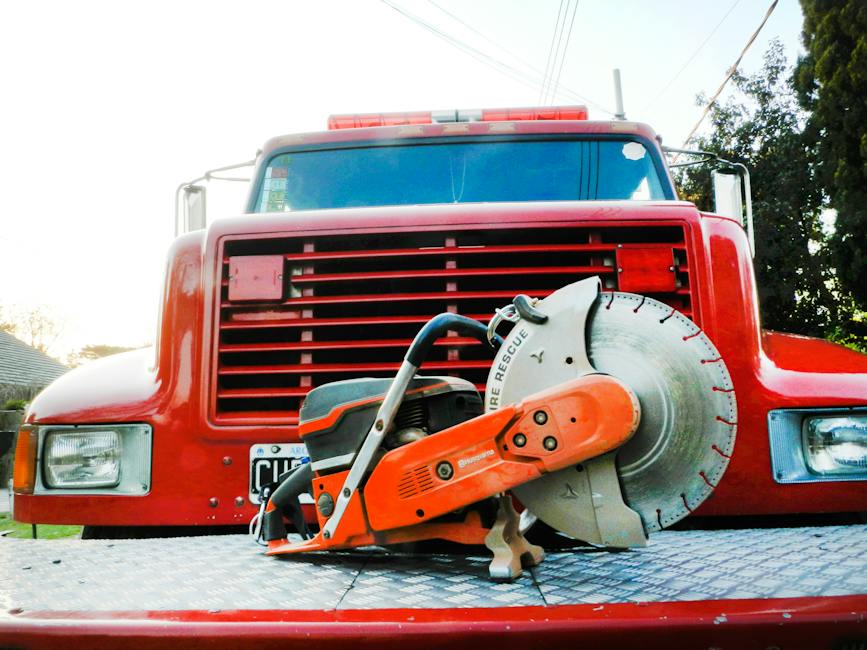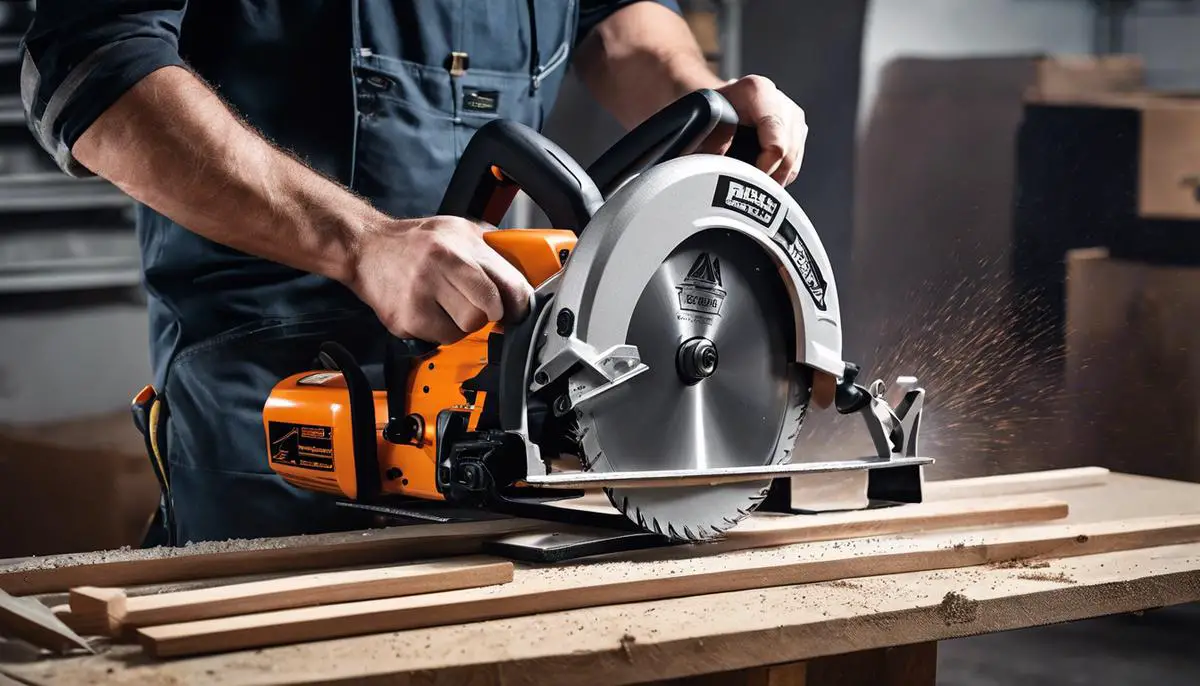Having a comprehensive knowledge and practical understanding of handheld concrete saws isn’t exclusive to construction professionals.
A growing number of enthusiasts and hobbyists are taking it upon themselves to learn about this versatile and powerful tool.
This guide will empower such individuals with a robust understanding of the essential features, components, and maintenance procedures associated with handheld concrete saws.
Additionally, it offers precious insights into the world of safety procedures, including the importance of proper gear, feed angle practices for stability and safety, as well as important protocols to follow in the event of a malfunction.
Understanding the Basics
Kickstarting Your Journey with Handheld Concrete Saws: A Comprehensive Guide
Embracing the world of DIY projects is not just fun, but it’s also incredibly rewarding. It’s like stepping into an expansive universe filled with promise, teeming with possibilities and fostering newfound skills as the journey goes on.
The hobby of using a handheld concrete saw is no different. It’s exhilarating to masterfully cut through concrete, creating whatever the heart desires.
It’s a venture that requires a good deal of insight and patience for learning. So don’t worry, remember – everyone starts somewhere!
First things first – picking the right saw. The key here is in the power source. Gas-powered handheld concrete saws are favorable for their strength and portability, perfect for those outdoor tasks.
The electric saws, while requiring continuous power supply, are ideal for indoor jobs due to their quieter and cleaner operation.
Battery-powered saws are also available, providing commendable versatility and freedom of movement, but they are not as powerful.
Next, comes the remarkable carbide-tipped blade. It’s the robust helping hand in cutting through concrete smoothly and efficiently.
The blade provides unmatched strength and precision, and comes with an array of options designed for different types of concrete.
Dense, large aggregate concrete requires a big, powerful blade; while porous, lightweight concrete needs a less aggressive, smaller blade.
Let’s not forget another crucial aspect – safety. Goggles and gloves are the first line of defense against potential flying debris.
Ear protection guards against the incessant loud noise. The respirator helps filter out the concrete dust, and the proper work boots provide a safeguard for the feet from potential mishaps. Safety, after all, is non-negotiable in any DIY project.
Now, the guide bar – the unsung hero. It supports and guides the saw blade, assisting in making straight cuts.
A well-maintained guide bar ensures that every cut is done with finesse and accuracy. From the standard guide bars suitable for most work, to the professional models with replaceable sprocket noses, the choices are ripe for the picking.
Of course, mastering the technique is key. Holding the saw securely, applying steady pressure and letting the blade do the work – these are the trademarks of a skilled user.
Moreover, learning how to deal with kickbacks, pinch points, and operator fatigue are skills earned with time and experience.
The golden rule remains – maintain a firm grip, yet allow the tool to make the cut.
The space of the handheld concrete saw hobby isn’t as intimidating as it may initially seem. It’s filled with immense rewards for those willing to invest the time into mastering this powerful, constructive tool.
Now, armed with the basics, it’s time to step into this fascinating world. So here’s to countless hours of delightful, rewarding cutting!
Safety Procedures
As we delve deeper into the thrilling world of operating a concrete saw, there are still some essential safety measures a savvy hobbyist should take into account.
These measures ensure that your journey remains an exhilarating ride rather than an encounter with mishaps.
First off, remember the critical caution: “Never cut deeper than the saw blade’s radius.” Going beyond this with the fervor of a passionate hobbyist could cause the blade to jam or ‘pinch’.
This can lead to a sudden jolt that could potentially result in an injury. Always adjust your cutting depth before you start to prevent ‘overcutting’.
Next, inspect the material you’re about to slice through. Are there any obstructions, such as metal rods, hidden within the concrete?
Remember, a concrete saw is built to handle concrete, not metal. Encountering unexpected elements during cutting can result in blade damage or even a dangerous scenario of kickback.
Acknowledge the importance of dust control. While we’ve covered the use of a respirator, managing the dust at the source is a practical preventative measure.
Using a water hose to dampen the area reduces airborne dust and can cool the blade, resulting in less wear and tear.
If you’re using an electric saw, though, stay mindful of the water-electricity mix (or rather, the lack thereof).
Speaking of electrical safety, be aware of your saw’s power source. If you’re using a gas-powered saw, ensure you’re working in a well-ventilated area to avoid inhaling harmful fumes.
If you’re sporting an electric one, always check the integrity of the power cord before each use. Safety starts even before the saw is switched on.
Beware of the saw’s kickback zone, which is typically at the upper quadrant of the blade’s edge. Kickbacks can be quite forceful and unexpected. Having a good grip and staying alert could keep you from harm’s way.
Finally, make the pre-work check your new mantra: inspect the blade for any wear and cracks, ensure the blade guard is correctly fitted, and double-check that the fuel and oil levels are appropriate. Maintenance is not a distraction, but an integral part of the safe use of a concrete saw.
Following these safety measures can lead to a gratifying and risk-free concrete saw operating experience. Here’s to seeing your passion thrive, responsibly!

Practical Operation
Continuing on, let’s delve into yet another crucial part of operating a handheld concrete saw seamlessly – the cutting depth.
It is tantamount to never exceed the saw blade’s radius in terms of cut depth. An overambitious cut depth could result in blade pinches and superfluous strain on the saw’s motor. Repeated abuse can drastically reduce the lifespan of the tool.
Before you make your cut, thoroughly inspect the material for any obstructions. Things like embedded rebar, wire mesh, or even a simple rock can cause premature blade wear or hazardous kickbacks.
If any of these obstructions are found, they should be removed or avoided during the cut whenever possible.
A significant aspect to be aware of in operating a concrete saw is dust control. Concrete sawing generates immense quantities of dust, which can be harmful when inhaled repeatedly over time.
To control this, dampen the intended cutting area with water, an effective and easily accessible dust suppressant.
Just ensure that proper measures are initially taken to prevent water from entering any electrical components of the saw.
Speaking of electricity, electrical safety is non-negotiable, whether the saw is gas-powered or electric. Both bring their own set of potential electrical hazards.
For electric saws, ensure that cords and outlets are free from defects and that the saw is connected to a Ground Fault Circuit Interrupter (GFCI).
Conversely, gas-powered saws demand care when refueling to avoid any spilling that may contact with a hot engine.
Another potential danger lies within the saw’s kickback zone. Kickbacks occur when the blade’s top quadrant makes contact with an object and lurches back towards the operator.
Therefore, avoid using this part of the blade to instigate cuts, and maintain a firm grip on the saw at all times to counteract any kickbacks.
Last but not least are the pre-work checks. An effective routine includes checking for blade wear or damage, the blade guard’s correct position, as well as the fuel and oil levels if dealing with a gas-powered saw.
It might seem akin to treading old ground, but remember, familiarity breeds prevention.
With these instructions and considerations, operating a handheld concrete saw can transition from a daunting task to an enjoyable and productive activity.
Always keep safety at the forefront, and the world of concrete cutting will be at your fingertips.
After going through this enriching guide, you will be more confident and skillful in handling a handheld concrete saw in a safe and effective manner.
You would have internalized key practical operation steps – from ensuring the blade’s positioning to adjusting the cutting pressure for smooth results, and master the switching off procedures.
This knowledge equips enthusiasts or hobbyists with the necessary know-how to effectively manipulate this tool, paves the way for successful do-it-yourself projects and sets the groundwork for a potential step into the professional world of construction and masonry.


